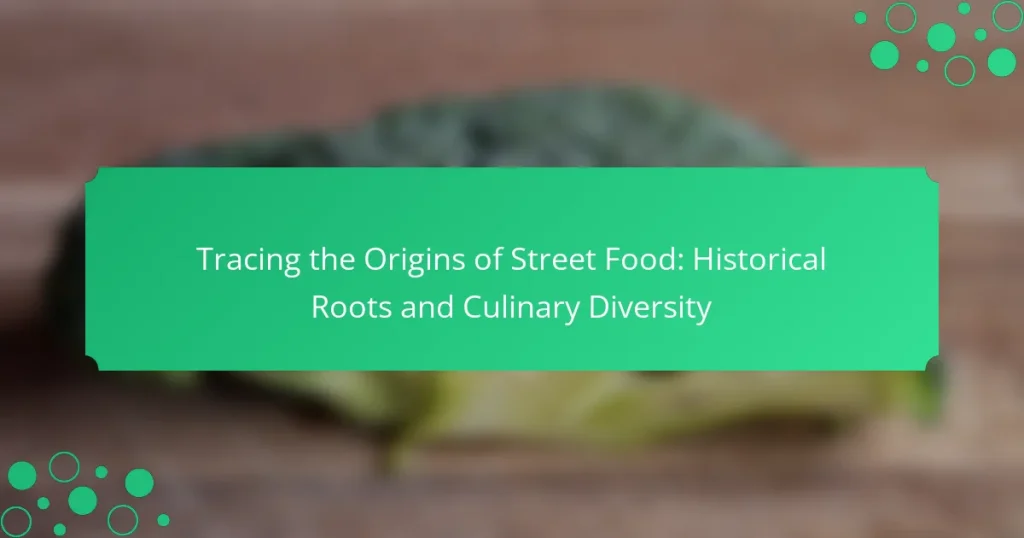Street food is a culinary phenomenon with historical roots that trace back to ancient civilizations, including Rome and Greece, where vendors provided affordable meals for workers and travelers. The global spread of street food through trade routes led to its prominence, particularly during the Tang Dynasty in China and the rise of urban centers in the 19th century. Today, street food showcases a rich diversity of flavors and cooking techniques, with unique dishes reflecting the culinary heritage of various cultures, such as tacos in Mexico and chaat in India. Additionally, street food plays a significant role in local economies, often catering to low-income populations and serving as a reflection of cultural identity and community traditions.

What are the historical roots of street food?
Street food has historical roots dating back to ancient civilizations. In ancient Rome, vendors sold hot foods and snacks on the streets. Archaeological evidence shows that street food was popular in ancient Greece as well. Street vendors provided affordable meals for workers and travelers. The concept of street food spread globally through trade routes. In Asia, street food became prominent during the Tang Dynasty in China. The rise of urban centers in the 19th century further popularized street food. Today, it reflects cultural diversity and culinary traditions worldwide.
How did street food evolve over time?
Street food evolved from ancient practices of selling food in public spaces. In ancient Rome, vendors sold bread and hot foods to citizens. Similarly, in Asia, street food became prevalent with vendors offering quick and affordable meals. The Industrial Revolution further accelerated this trend, as urbanization increased the demand for convenient food options. By the 20th century, street food diversified globally, reflecting local cultures and cuisines. Today, street food is a significant part of culinary tourism, attracting food lovers worldwide. The rise of social media has also popularized street food, allowing vendors to reach larger audiences.
What were the earliest forms of street food in ancient civilizations?
The earliest forms of street food in ancient civilizations included simple, portable foods sold by vendors. In ancient Rome, street food consisted of items like bread, cheese, and fried fish. Vendors in ancient Greece offered foods such as olives and honey cakes. In China, food stalls sold dumplings and rice dishes as early as the Han Dynasty. Evidence from archaeological sites shows that these foods were consumed by all social classes. Street food provided convenient options for workers and travelers. The practice of selling food in public spaces was common in bustling marketplaces. These early street foods laid the foundation for contemporary street food culture.
How did trade routes influence the development of street food?
Trade routes significantly influenced the development of street food by facilitating the exchange of ingredients and culinary techniques. These routes enabled merchants to transport spices, grains, and other food items across regions. For example, the Silk Road connected Asia to Europe, allowing for the introduction of diverse flavors and cooking methods. As a result, local street food evolved by incorporating these new ingredients.
Street vendors adapted their offerings to reflect the tastes and preferences of travelers and locals alike. This led to a fusion of culinary traditions, creating unique street food dishes. Historical records indicate that cities along trade routes became hubs for vibrant street food cultures. The accessibility of diverse ingredients made it possible for street food to flourish in urban settings.
What role did street food play in different cultures?
Street food has served as a vital aspect of cultural identity across various societies. It provides accessible, affordable meals for people from all walks of life. In many cultures, street food reflects local culinary traditions and ingredients. For instance, in Thailand, street vendors offer dishes like pad Thai, showcasing regional flavors. In Mexico, tacos from street stalls highlight the country’s rich culinary heritage. Street food also fosters community interaction, as people gather around vendors. Historically, it has been a means of economic livelihood for many families. In urban areas, street food contributes to the local economy and tourism. Overall, street food embodies cultural diversity and social connection.
How do cultural traditions shape street food offerings?
Cultural traditions significantly shape street food offerings by influencing the ingredients, cooking methods, and presentation styles. Each culture has unique flavors and dishes that reflect its history and geography. For example, in Mexico, street food often features corn-based items like tacos and elotes, rooted in indigenous practices. In India, spices and regional ingredients dictate the variety of street snacks, showcasing local agricultural products. Festivals and communal gatherings also play a role, as specific foods are prepared to celebrate traditions. This connection to cultural heritage ensures that street food remains a vibrant expression of local identity. Studies show that street food is often a reflection of socio-economic factors, making it accessible and representative of the community’s culinary heritage.
What are some notable street food festivals around the world?
Notable street food festivals around the world include the Night Noodle Markets in Australia. This festival showcases Asian street food and attracts thousands of visitors each year. Another prominent festival is the Street Food Festival in Florence, Italy, which celebrates local and international street food. The festival features food trucks and stalls offering diverse culinary delights. In the United States, the Los Angeles Street Food Festival highlights the city’s vibrant food truck culture. This event features a wide array of cuisines from various cultures. The Singapore Food Festival is also significant, focusing on Singaporean street food and culinary heritage. Each of these festivals emphasizes the cultural diversity and culinary creativity found in street food.

What culinary diversity exists within street food?
Culinary diversity within street food encompasses a wide range of flavors, ingredients, and cooking techniques. Different cultures contribute unique dishes that reflect their culinary heritage. For example, tacos from Mexico feature various fillings like meat, beans, and vegetables. In India, street food includes chaat, a mix of spices, potatoes, and chickpeas. Southeast Asia offers dishes like pad Thai, which combines rice noodles, shrimp, and peanuts. Each region’s street food showcases local ingredients and traditional cooking methods. This diversity highlights the adaptability and creativity of street food vendors worldwide. Street food often serves as a reflection of cultural identity and community traditions.
How do regional ingredients influence street food dishes?
Regional ingredients significantly influence street food dishes by shaping their flavors, textures, and overall appeal. Each region’s climate, agriculture, and local markets dictate the availability of specific ingredients. For example, coastal areas often feature seafood prominently in their street food, while inland regions may focus on meats and grains.
Cultural traditions also play a role in ingredient selection. Certain spices or cooking methods may be favored in specific areas, enhancing the uniqueness of local dishes. Additionally, street food often reflects the history of migration and trade, incorporating diverse ingredients that tell a story of cultural exchange.
For instance, the use of chili peppers in Mexican street food can be traced back to indigenous cultivation, while the incorporation of rice in Asian street food highlights agricultural practices in those regions. Overall, regional ingredients are essential in defining street food, making each dish a representation of its geographical and cultural context.
What are some unique street food items from specific regions?
Unique street food items vary by region and reflect local culture. In Mexico, tacos al pastor feature marinated pork, pineapple, and onion. This dish originated from Lebanese immigrants adapting shawarma techniques. In India, pani puri consists of hollow, crispy puris filled with spicy water and tamarind. It is a popular snack in street markets. In Thailand, pad thai is a stir-fried noodle dish with shrimp, tofu, and peanuts. It is a national dish that showcases Thai culinary influences. In Japan, takoyaki are savory balls filled with octopus, green onion, and batter. They originated in Osaka and are a favorite street food. In Italy, arancini are stuffed rice balls, typically filled with ragù or cheese. They come from Sicilian cuisine and are often sold at food stalls. Each of these street foods highlights the unique flavors and cooking traditions of their respective regions.
How do local cooking techniques impact street food preparation?
Local cooking techniques significantly influence street food preparation by dictating methods, flavors, and presentation. Each region’s culinary traditions shape the ingredients used in street food. For example, grilling techniques in Southeast Asia create distinct smoky flavors. In contrast, frying methods in Latin America produce crispy textures.
Additionally, local spices and herbs enhance the taste profiles of street foods. Techniques such as steaming in Asian cultures preserve nutrients while providing unique textures. Furthermore, the use of open flames or charcoal in many cultures adds a traditional element to the cooking process.
Street food vendors often adapt these techniques to suit local tastes and preferences. This adaptability helps maintain cultural relevance and authenticity. Overall, local cooking techniques are essential in defining the character and appeal of street food.
What are the health considerations of street food?
Street food can pose various health considerations. These include food safety, hygiene practices, and nutritional content. Food safety is critical as improper handling can lead to foodborne illnesses. A study by the World Health Organization states that around 600 million people fall ill after eating contaminated food each year. Hygiene practices vary among vendors, impacting the risk of illness. Nutritional content can also be a concern. Many street foods are high in fats, sugars, and sodium. This can contribute to health issues like obesity and hypertension. Therefore, consumers should be cautious and choose vendors with good hygiene practices and healthier options.
How can consumers ensure food safety when choosing street food?
Consumers can ensure food safety when choosing street food by observing hygiene practices. They should select vendors who maintain clean cooking areas. Inspecting the food for freshness is crucial. Consumers should avoid items that have been sitting out for long periods. Observing the vendor’s handling of food can indicate safety standards. Vendors wearing gloves and hairnets demonstrate good practices. Checking for high customer turnover can also be a positive sign. According to the World Health Organization, proper food safety practices can reduce foodborne illnesses significantly.
What are the nutritional aspects of popular street food items?
Popular street food items often contain a mix of carbohydrates, proteins, fats, vitamins, and minerals. For example, a typical serving of street tacos may provide around 300 calories, with significant protein from meat and fiber from vegetables. Fried foods, such as samosas, are high in calories and fats but can provide some dietary fiber and protein.
Nutritional content varies widely by region and preparation method. In Asia, street food like pho is rich in protein and vitamins from herbs and vegetables. In contrast, North American street foods often emphasize high sugar and fat content, such as funnel cakes.
Research indicates that street food can be a significant source of daily nutrients for many people. According to a study published in the Journal of Food Science, street food can contribute to essential micronutrient intake, despite potential health risks associated with hygiene.
Overall, while street food can offer nutritional benefits, it is essential to consider preparation methods and ingredient choices for a balanced diet.

How does street food reflect social and economic factors?
Street food reflects social and economic factors through its accessibility and cultural significance. It often caters to low-income populations, providing affordable meal options. This affordability showcases economic disparities within societies. Additionally, street food vendors frequently represent local traditions and culinary heritage. Their offerings reflect the preferences and tastes of the surrounding community. Street food can also indicate urbanization trends, as cities grow and more people seek convenient dining options. Research shows that street food markets can stimulate local economies by creating jobs and attracting tourism. For example, in cities like Bangkok and Mexico City, street food is a vital part of the local economy and culture.
What is the economic impact of street food vendors on local communities?
Street food vendors significantly contribute to local economies. They create jobs, support local agriculture, and stimulate tourism. In urban areas, street food can provide affordable dining options, enhancing community accessibility to diverse cuisines. Studies show that street food vendors generate billions in revenue annually. For instance, in cities like Bangkok, street food accounts for a substantial portion of the local economy. Additionally, vendors often source ingredients from nearby farmers, fostering local supply chains. This practice strengthens community ties and supports small-scale agriculture. Overall, street food vendors play a vital role in enhancing economic vitality within local communities.
How does street food contribute to urban economies?
Street food contributes significantly to urban economies by providing affordable dining options. It creates job opportunities for vendors and supports local suppliers. Street food often stimulates tourism, attracting visitors to urban areas. A study by the World Bank indicates that street food can account for up to 50% of a city’s food economy. This sector encourages entrepreneurship, allowing individuals to start small businesses with lower capital investment. Additionally, street food enhances the cultural identity of cities, promoting local traditions and flavors. Overall, street food plays a vital role in economic development and community engagement in urban settings.
What challenges do street food vendors face in different regions?
Street food vendors face various challenges that differ by region. In developing countries, limited access to clean water and sanitation is a common issue. This can lead to food safety concerns and health risks for both vendors and customers. Regulatory barriers also pose significant challenges. Many vendors operate without proper licenses, facing fines or shutdowns.
In urban areas, competition is fierce. Vendors must differentiate their offerings to attract customers. Economic factors also play a role. Fluctuating prices of ingredients can affect profitability. Additionally, cultural perceptions of street food can impact sales. In some regions, street food is viewed as inferior to restaurant dining.
Weather conditions can also be a challenge. Rain or extreme heat can deter customers and impact sales. Moreover, the COVID-19 pandemic introduced new hurdles, including health regulations and reduced foot traffic. These challenges highlight the complex environment in which street food vendors operate globally.
What trends are shaping the future of street food?
Health-conscious options are shaping the future of street food. Consumers increasingly seek nutritious meals. This trend is evident in the rise of vegan and plant-based offerings. Sustainability is also becoming crucial. Many vendors are opting for locally sourced ingredients. Technology is enhancing the street food experience. Mobile apps for ordering and delivery are gaining popularity. Additionally, fusion cuisines are attracting diverse audiences. Street food is evolving to include global flavors and innovative combinations. These trends reflect changing consumer preferences and lifestyle choices.
How is globalization affecting street food culture?
Globalization is significantly transforming street food culture worldwide. It facilitates the exchange of culinary practices across borders. Street food vendors are increasingly incorporating international flavors into their offerings. For example, Asian street food often features Western ingredients and cooking techniques. This blending creates fusion dishes that attract diverse clientele. Additionally, globalization enhances the visibility of street food through social media and food blogs. These platforms allow vendors to reach a global audience quickly. Consequently, street food has become a cultural ambassador for local cuisines. The rise of food festivals celebrating street food further supports this trend.
What innovations are emerging in the street food scene?
Innovations in the street food scene include food trucks, gourmet offerings, and technology integration. Food trucks have revolutionized accessibility, allowing chefs to reach diverse locations. Gourmet street food elevates traditional dishes with high-quality ingredients and creative presentations. Technology integration involves mobile apps for ordering and payment, enhancing customer convenience. Sustainability practices are also emerging, with vendors using eco-friendly packaging and sourcing local ingredients. Ghost kitchens are gaining popularity, focusing solely on delivery without a physical storefront. These innovations reflect changing consumer preferences and the desire for unique culinary experiences.
What tips can enhance the street food experience?
Choose popular vendors with long lines. This indicates quality and freshness. Look for stalls that use local ingredients. Fresh, regional produce enhances flavor. Try dishes that are unique to the area. This offers an authentic culinary experience. Observe food safety practices at the vendor. Clean preparation areas are crucial for health. Ask locals for recommendations. They often know the best spots. Be adventurous and try new flavors. Street food is about exploration and discovery. Enjoy the vibrant atmosphere and engage with vendors. Personal interactions can enrich the experience.
How can one choose the best street food vendors?
To choose the best street food vendors, prioritize cleanliness and food safety practices. Look for vendors with a clean cooking area and well-maintained equipment. Observe the vendor’s food handling techniques to ensure they follow hygiene protocols. Check for high customer turnover, as this indicates fresh food and popularity. Read reviews and ratings on food apps or social media to gather insights from previous customers. Look for vendors who use fresh, local ingredients to enhance flavor and quality. Consider the variety of offerings, as diverse menus often indicate culinary expertise. Trust your instincts; if a vendor seems unprofessional or the food looks unappetizing, choose another option.
What are some must-try street food dishes from around the world?
Tacos from Mexico are a must-try street food dish. They consist of a folded or rolled tortilla filled with various ingredients. Popular fillings include grilled meats, beans, and vegetables. Another iconic dish is the Vietnamese Bánh mì. This sandwich combines French baguettes with Vietnamese ingredients like pork, pickled vegetables, and cilantro.
In India, Pani Puri is a popular street snack. It features hollow, crispy puris filled with spiced water, tamarind, and chickpeas. The Japanese Takoyaki is also a favorite. These are savory balls filled with diced octopus and topped with sauces.
In Thailand, Pad Thai is a well-known street dish. It consists of stir-fried rice noodles with shrimp, tofu, and peanuts. Finally, the Middle Eastern Shawarma is a must-try. This dish features marinated meat cooked on a vertical rotisserie and served in pita bread. Each of these dishes reflects the culinary diversity of street food around the world.
The main entity of the article is street food, which has historical roots tracing back to ancient civilizations, including Rome and Greece. The article explores the evolution of street food over time, highlighting its significance in cultural identity and local economies. It examines the influence of trade routes on culinary diversity and the role of regional ingredients and cooking techniques in shaping street food offerings. Additionally, the article addresses health considerations, challenges faced by vendors, and emerging trends and innovations in the street food scene, providing a comprehensive overview of its cultural and economic impact worldwide.



